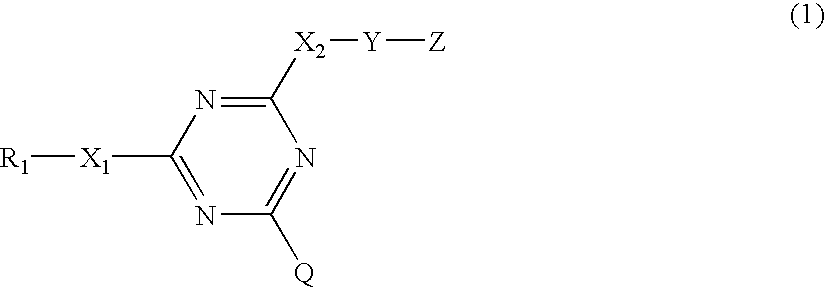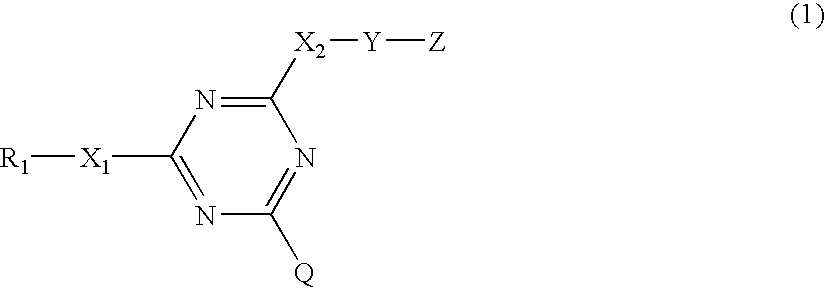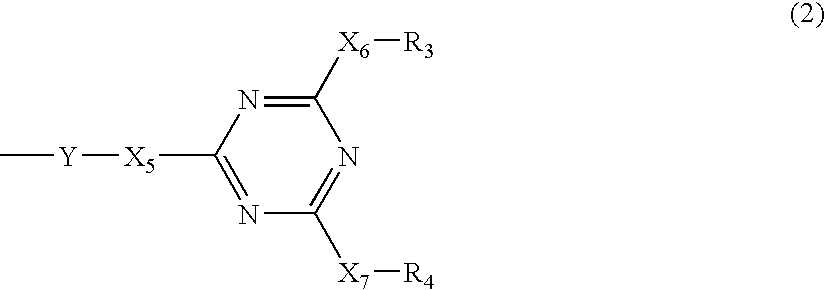Pigment dispersing agent, pigment composition containing the same and pigment dispersion containing the same
a pigment dispersing agent and pigment composition technology, applied in the field of pigment dispersing agents, can solve the problems of inability to provide the above properties, difficulty in achieving the above properties, and insufficient pigment composition production, so as to achieve excellent fluidity and dispersion stability, excellent gloss
- Summary
- Abstract
- Description
- Claims
- Application Information
AI Technical Summary
Benefits of technology
Problems solved by technology
Method used
Image
Examples
preparation example 1
[0056]20 Parts of 5-aminobenzimidazolone and 25 parts of cyanuric chloride were added to 300 parts of methanol, and the mixture was allowed to react at 20° C. or lower for 2 hours. Then, 34 parts of aminoethanesulfonic acid, 27 parts of sodium hydroxide and 700 part of water were added, and the resultant mixture was refluxed under heat for 4 hours. Then, the mixture was cooled down to 60° C., 170 parts of 10% aluminum sulfate aqueous solution was added, and the resultant mixture was stirred at 60° C. for 1 hour, followed by filtration, washing with water and drying, to obtain 60 parts of a pigment dispersing agent (a) shown in Table 1.
preparation example 2
p Preparation Example 2
[0057]40 Parts of 5-aminobenzimidazolone and 25 parts of cyanuric chloride were added to 500 parts of methanol, and the mixture was allowed to react at 50° C. for 2 hours. Then, 18 parts of 6-aminocaproic acid, 22 parts of sodium hydroxide and 1,000 part of water were added, and the mixture was refluxed under heat for 4 hours. Then, the mixture was cooled down to 60° C., 450 parts of 10% stearylamine acetate aqueous solution was added, and the resultant mixture was stirred at 60° C. for 1 hour, followed by filtration, washing with water and drying, to obtain 94 parts of a pigment dispersing agent (b) shown in Table 1.
preparation example 3
[0058]28 Parts of 3-amino-9-ethylcarbazole and 25 parts of cyanuric chloride were added to 300 parts of methanol, and the mixture was allowed to react at 20° C. or lower for 2 hours. Then, 21 parts of 5-aminosalicylic acid, 22 parts of sodium hydroxide and 700 part of water were added, and the mixture was allowed to react at 60° C. for 4 hours. Then, 1,000 part of water and 100 parts of 35% hydrochloric acid were added, and the mixture was refluxed under heat for 4 hours, followed by filtration, washing with water and drying, to obtain 55 parts of a pigment dispersing agent (c) shown in Table 1.
PUM
| Property | Measurement | Unit |
|---|---|---|
| amine value | aaaaa | aaaaa |
| incident angle | aaaaa | aaaaa |
| dispersion | aaaaa | aaaaa |
Abstract
Description
Claims
Application Information
 Login to View More
Login to View More - R&D
- Intellectual Property
- Life Sciences
- Materials
- Tech Scout
- Unparalleled Data Quality
- Higher Quality Content
- 60% Fewer Hallucinations
Browse by: Latest US Patents, China's latest patents, Technical Efficacy Thesaurus, Application Domain, Technology Topic, Popular Technical Reports.
© 2025 PatSnap. All rights reserved.Legal|Privacy policy|Modern Slavery Act Transparency Statement|Sitemap|About US| Contact US: help@patsnap.com



